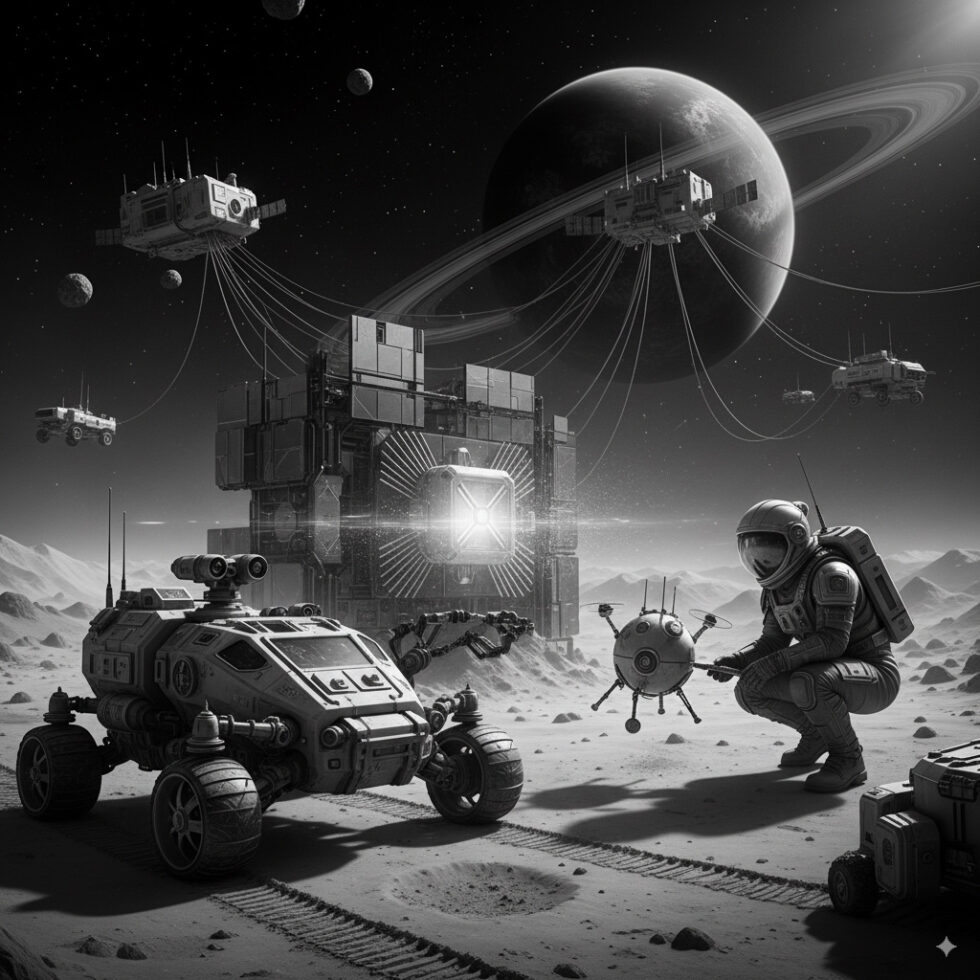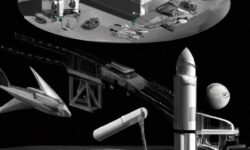
Not every space trend turns on a flashy new rocket or an epic first landing. Many of the most important shifts underway are quiet, technical, and surprisingly down to Earth in spirit: keeping dust off gear, guiding spacecraft safely through solar storms, or letting onboard software make decisions faster than a human can. This is the subtle layer of space science that turns big ideas into working hardware—and ultimately, into discoveries.
This article takes you inside that quiet layer. We’ll look at how space weather is changing mission planning during an active solar cycle, how lunar dust threatens everything from seals to optics, why autonomy is now a core capability rather than a nice-to-have, and what emerging tools in exoplanet imaging, planetary defense, and space-based gravitational wave detection are teaching us about designing for reality instead of ideal conditions. Along the way, we’ll keep the language simple, the claims grounded, and the focus on practices you can recognize across many missions.
Space Weather Is Getting Personal
The Sun isn’t just a flashlight in the sky; it’s an engine that constantly pushes charged particles and magnetic fields toward us. When it flares or ejects a plasma cloud, satellites feel it almost immediately. The current solar cycle is active, and every mission—from tiny cubesats to planetary probes—now bakes space weather into its plans.
What “space weather” really does to spacecraft
- Radiation spikes can flip bits in memory, forcing reboots or corrupting data.
- Charged particle storms can charge surfaces unevenly, causing discharges that may damage electronics.
- Atmospheric swelling during geomagnetic storms increases drag on low‑Earth satellites, changing orbits.
- HF radio blackouts and GPS errors can complicate navigation and communications.
Designing for storms you can’t control
New hardware isn’t helpless. Teams mix traditional radiation hardening with smarter operations:
- Predict and pause: Forecasts from services like NOAA’s Space Weather Prediction Center guide “storm diets” for satellites—pausing sensitive activities, lowering voltages, or switching to safe modes until conditions improve.
- Layered memory protection: Error‑correcting codes (ECC) and watchdog circuits catch bit flips before software spirals.
- Choice of orbit: Highly inclined low‑Earth orbits often pass through the South Atlantic Anomaly, a radiation hotspot. Some missions simply avoid it.
- Dynamic drag management: Operators adjust attitude or deploy drag surfaces to counter unexpected air density after a solar storm.
Why it matters now
Because the same solar physics applies everywhere, techniques proven today support tomorrow’s missions to Mars, asteroids, and the outer planets, where real‑time intervention isn’t possible. Building resilience into software and procedures is now as important as the thickness of a radiation shield.
Lunar Dust: The Small Problem That Grows on Everything
The Moon’s dust—called regolith—is a nasty mix of sharp, glassy particles and fine powder that clings to surfaces via static charge. It’s not like beach sand. It scratches visors, gums up hinges, and threatens to infiltrate air systems. The more activity at the Moon’s poles, the more dust becomes a mission driver.
Why lunar dust is so stubborn
There’s no weathering by water or wind to round off edges. Micrometeorites continuously grind and melt surface material, creating jagged fragments. Without an atmosphere, particles build up electrostatic charges in sunlight and cling to anything they touch. The result: a substance that behaves like a powdery glue with knives in it.
Mitigation strategies getting real
- Suitports and airlock hygiene: Instead of bringing suits into habitats, astronauts dock suits to the exterior and step in from inside, leaving most dust outside.
- Anti‑dust coatings: Research groups have demonstrated spray‑on materials that repel charged particles, reducing buildup on optics and solar panels.
- Electrodynamic dust removal: Thin electrodes pulsed with specific voltages can “walk” dust off surfaces without brushes or air.
- Design for cleanability: Flat panels, fewer crevices, sacrificial covers on lenses, and easy‑to‑swap filters all help.
Polar missions add another twist
Targets near the lunar south pole include permanently shadowed regions that can be extremely cold. In those temperatures, frost and volatiles behave differently than dust in sunlit areas. Tools and seals must work across dramatic temperature gradients, which can cause gaskets to stiffen and lubricants to thicken. The theme repeats: materials, coatings, and interfaces make or break ambitious science.
Autonomy Goes From Optional to Essential
Deep‑space networks are powerful, but time delays and limited contact windows force spacecraft to handle more tasks alone. Autonomy has moved beyond “don’t crash” into the realm of planning, choosing, and adapting in the moment.
What spacecraft are doing on their own
- Navigation: Landmark‑based guidance lets a probe match its path to a target without constant updates from Earth.
- Hazard avoidance: Rovers spot and go around obstacles, selecting safe paths while keeping science in mind.
- Target selection: Instruments can prioritize interesting features—like unusual rocks or plume events—and snap data before the moment passes.
- Health management: Onboard monitors adjust settings when temperatures drift or power sags, keeping systems alive between check‑ins.
The new design rule: close the loop onboard
A good autonomous system pairs fast sensing with clear guardrails. Teams define boundaries—power limits, thermal limits, safe areas—and let the spacecraft optimize within those lines. The upside is huge: more useful data, fewer misses, and better use of precious downlink time. The cost is upfront complexity and thorough testing to prevent surprise behavior.
Why this pays off across missions
On Mars, autonomy means a rover can drive farther each day. In asteroid missions, it means a probe can align for sampling in minutes, not hours. Around the Moon, it means landers can fine‑tune their descent even if a scheduled relay passes behind a ridge. The common pattern is a tight loop of sense–decide–act that is robust against delays and outages.
Exoplanet Reality Checks: From Spectra to Chemistry
Telescopes like JWST are opening tiny windows into exoplanet atmospheres. But the excitement comes with a caution label. Interpreting faint spectra is hard. Starlight filters through a planet’s air, bounces off clouds, and is modulated by a star that is constantly changing. Separating signal from noise, and chemistry from instrument artifacts, is the new craft of the field.
What we can actually read today
For large, hot planets, JWST can detect water vapor, methane, carbon dioxide, and sometimes carbon monoxide. For smaller, cooler worlds—the kind that might be rocky—the signals are weaker and more easily muddled by stellar activity. Claims of biologically interesting signatures must pass strict tests: do multiple instruments agree? Could starspots or hazes mimic the signal? Is the inferred chemistry self‑consistent?
Calm methods for bold questions
- Multi‑instrument confirmation: Cross‑checking results across independent observations is the baseline standard.
- Stellar contamination modeling: Accounting for starspots and faculae reduces false positives.
- Retrieval transparency: Publishing assumptions, priors, and model choices helps the community test sensitivity.
- Null tests: Applying the same pipeline to objects that should show no signature helps reveal hidden biases.
What’s next: sharper eyes and better starlight suppression
Future telescopes will push deeper using extreme coronagraphs and possibly starshades to block a star’s glare. The goal is simple to say and hard to do: collect clean light from an Earth‑like planet and split it finely enough to read its atmospheric mix. The path there is filled with wavefront control, ultra‑stable optics, and careful calibration—the unflashy side of exoplanet gold hunting.
Planetary Defense Grows Up
Not long ago, a mission designed to nudge an asteroid sounded like science fiction. Then a spacecraft hit a small asteroid moon and changed its orbit measurably. That demonstration flipped “maybe” into “yes, physics works.” Now the focus is on speed: how quickly can we find, characterize, and, if needed, gently push a hazardous rock off course?
Find them early, act with margin
The earlier we find a potentially hazardous object, the smaller the action required. Detecting heat glow in the infrared, especially for dark asteroids, improves the tally. Once an object is found, the job is to refine its orbit, measure its size and composition, and decide whether a kinetic nudge or a more subtle method (like gravity tractor) suits it best.
Practice, then practice more
- Follow‑up missions to a previously impacted asteroid refine models of how rubble piles respond.
- Simulation campaigns test observation and deflection plans against thousands of what‑ifs, from awkward spin states to binary systems.
- Global drills with observatories and space agencies exercise discovery-to-decision timelines.
The quiet lesson
Deflection isn’t just about power. It’s about knowledge per hour: how quickly we can turn sparse observations into a confident plan. That means better infrared surveys, better orbit determination, and faster physical characterization (density, porosity, spin). Again, it’s the software and workflows behind the scenes that transform a heroic attempt into a reliable procedure.
Venus, The Tough Teacher
Interest in Venus is back, and for good reason. It’s roughly Earth’s size but with a surface hot enough to melt lead, bone‑dry air thick with carbon dioxide, and clouds laced with sulfuric acid. Sending instruments there is the electronics version of weightlifting at altitude. Just surviving offers a payoff: learning how rocky worlds diverge into very different end states.
Survival basics in a 465°C oven
- Short, targeted descents: Atmospheric probes that fly through and transmit quickly before heat soaks in.
- High‑temperature materials: Ceramics and silicon carbide electronics extend survival without bulky cooling.
- Simple, robust sensors: Fewer moving parts and direct measurements—pressure, temperature, bulk gas composition—reduce failure points.
Why Venus technology matters elsewhere
Hardware that survives extreme heat can also handle the hot side of Mercury, lunar midday, or the belly of a sample‑return capsule during reentry. Resilience developed for one mission often becomes a standard part on another, enabling more ambitious science without redesigning the basics each time.
Nuclear Thermal Propulsion and Quiet Power
Solar panels work wonderfully near Earth and Mars, but their usefulness fades as sunlight weakens. Meanwhile, some missions need high thrust without guzzling propellant. Two nuclear ideas are back in focus: nuclear thermal propulsion for fast transfers and compact fission power for steady electricity in shadowed or distant locations.
What nuclear thermal can change
In nuclear thermal propulsion, a reactor heats hydrogen propellant, which expands through a nozzle to produce thrust. It can roughly double the efficiency of chemical rockets, meaning faster trips or heavier payloads with the same fuel. For crewed missions, shaving months off travel time reduces radiation exposure and logistical risk. Key challenges include fuel design, materials that tolerate extreme temperatures, and clear operational safety rules.
Power when sunlight is scarce
On the Moon’s poles and during long night cycles, reliable power keeps habitats warm and instruments alive. Compact fission systems promise kilowatts to tens of kilowatts of steady output for years. They complement solar and batteries instead of replacing them, offering another layer of resilience when dust, shadow, or distance make photons unreliable.
LISA and the New Sense for the Universe
Gravitational wave detectors on Earth have already listened to black holes collide. Putting a detector in space unlocks a different band of frequencies, revealing heavier, slower dances of massive black holes and possibly new physics. A space‑based interferometer spreads laser arms millions of kilometers apart, creating an instrument that is more like a musical ear than a camera.
Why a longer baseline matters
Low‑frequency gravitational waves travel freely across the cosmos, carrying clean information about events we can’t see with light. Observing them requires an arm length longer than Earth can host. With test masses floating in near‑perfect free fall, laser links measure changes smaller than the width of an atom over planetary distances. The data is complex, but the principle is simple: measure tiny timing changes as spacetime itself ripples.
New science, new engineering
- Galaxy formation history: Watching massive black holes merge tells us how galaxies grew and collided.
- Extreme gravity tests: Precise waveforms probe the edges of general relativity.
- Technology spin‑offs: Ultra‑stable lasers, precision metrology, and drag‑free control systems benefit many missions.
Design Habits That Win Across All These Frontiers
Across space weather, dust control, autonomy, exoplanet spectroscopy, planetary defense, and gravitational wave detection, the same design habits appear. They are not glamorous, but they build missions that finish what they start.
Focus on interfaces
Dust gets in. Heat sneaks through. Connectors loosen. Paying early attention to how parts meet—seals, thermal joints, harness routes—reduces both failure risk and maintenance work. A well‑designed interface is like a good sentence: it reads cleanly and does not hide a trap.
Make operational plans as real as hardware
Checklists, safe modes, and contingency flows are as important as bolts and code. Practice them with simulations and tabletop drills. The goal is not to predict every failure, but to make reacting to a surprise feel like following a familiar script.
Instrument humility
Assume first results are wrong in some small way. Try to break findings with alternative pipelines, compare against null cases, and let other teams audit the reasoning. This culture raises the chance that a bold claim will stick, especially in fields like exoplanets where signals are faint and models are strong.
Autonomy with boundaries
Give spacecraft room to be clever, but wrap that room in clear limits. “Never drain a battery below X.” “Never point an open telescope within Y degrees of the Sun.” Boundaries let autonomy deliver speed without courting avoidable mistakes.
What to Watch in the Next Few Years
A few near‑term milestones will test and showcase the themes above:
- Space weather operations: A string of strong solar events will keep operators busy refining storm protocols.
- Lunar surface tests: Early landers will trial dust‑resistant coatings, surface power concepts, and autonomous landing tweaks near challenging terrain.
- Exoplanet scrutiny: New JWST spectra will sharpen best practices for validation, while next‑gen coronagraphs mature in preparation for future flagship missions.
- Planetary defense drills: Infrared surveys and follow‑on reconnaissance will shorten the timeline from discovery to viable mitigation plan.
- Precision metrology in space: Technology steps toward space‑based gravitational wave detection will advance laser stability and drag‑free control.
Each of these milestones hides a lesson about how to thrive in hard environments. If you only watch the big headlines, you might miss the real progress: quieter systems that fail less, instruments that trust their own judgment, and teams that treat space weather, dust, and data integrity as first‑class citizens.
Summary:
- Space weather management now shapes daily operations, with forecasts, safe modes, and radiation‑aware design as standard practice.
- Lunar dust is a mission driver; coatings, electrodynamic cleaning, suitports, and cleanable designs reduce risk.
- Autonomy has matured into onboard decision‑making for navigation, hazard avoidance, target selection, and health management.
- Exoplanet science demands careful validation; multi‑instrument checks and transparent retrievals guard against false claims.
- Planetary defense is focusing on faster discovery and characterization to enable gentle, early mitigation.
- Extreme‑environment tech for Venus strengthens missions across the Solar System by pushing materials and electronics.
- Nuclear thermal propulsion and compact fission power add speed and reliability when sunlight is limited.
- Space‑based gravitational wave detection will open a new window on the universe and drive advances in precision instrumentation.
External References:
- NOAA Space Weather Prediction Center
- NASA Parker Solar Probe
- ESA: Hera Mission
- NASA: James Webb Space Telescope
- NASA Exoplanets: Starshade Technology
- ESA: LISA Overview
- NANOGrav: Pulsar Timing Array Collaboration
- NASA: DAVINCI Venus Mission
- NASA: VERITAS Venus Mission
- NASA: Habitable Worlds Observatory (Concept)





